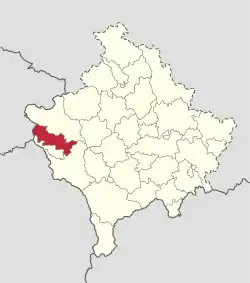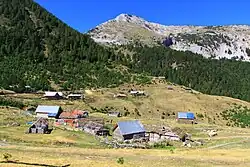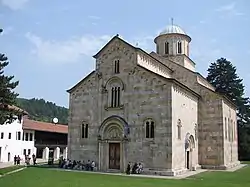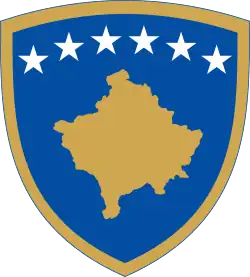Deçan Municipality | |
|---|---|
| Komuna e Deçanit Opština Dečani / Општина Дечани | |
 Flag  Seal | |
 Location of the municipality of Deçan within Kosovo | |
| Coordinates: 42°32′N 20°17′E / 42.533°N 20.283°E | |
| Country | Kosovo |
| District | District of Gjakova |
| Government | |
| • Mayor | Bashkim Ramosaj |
| Area | |
| • Municipality | 297 km2 (115 sq mi) |
| • Rank | 20th in Kosovo |
| Elevation | 550 m (1,800 ft) |
| Population (2011) | |
| • Municipality | 40,019 |
| • Density | 130/km2 (350/sq mi) |
| • Urban | 3,803 |
| Time zone | UTC+1 (CET) |
| • Summer (DST) | UTC+2 (CEST) |
| Postal code | 51000 |
| Area code | +383 390 |
| Vehicle registration | 03 |
| Website | kk |
Deçan Municipality or Dečani Municipality (Albanian: Komuna e Deçanit; Serbian: Општина Дечани, Opština Dečani, pronounced [dɛ̌t͡ʃani]) is a municipality located in the District of Gjakova of Kosovo. The seat is the town of Deçan. According to the 2011 census, the municipality has 40,019 inhabitants, with 3,803 inhabitants in the town of Deçan.
It is a mountainous area which borders Montenegro and Albania. There is a total of 37 settlements in the municipality. The municipality covers an area of 297 km2 (115 sq mi).
During the 1998–1999 war, Deçan was one of the strongholds of the Kosovo Liberation Army (KLA) and subsequently suffered a large amount of infrastructure destruction by the Serbian police and paramilitary forces. Much reconstruction has taken place with the assistance of the international agencies and support from the Kosovo Albanian diaspora.
Geography
.jpg.webp)
Deçan lies in the Bjeshkët e Nemuna mountain range, part of Albanian Alps. It is surrounded by the Beleg Mountain.
List of settlements

List of settlements:[1]
| Albanian name | Serbian name |
|---|---|
| Baballoq | Babaloć |
| Carrabreg i Epërm | Gornji Crnobreg |
| Carrabreg i Poshtem | Donji Crnobreg |
| Deçan | Dečani |
| Drenoc | Drenovce |
| Dubovik | Dubovik |
| Gllogjan | Glođane |
| Gramaçel | Gramočelj |
| Jasiq | Jasić |
| Kodrali | Kodralija |
| Lëbushë | Ljubusa |
| Lloqan | Locan |
| Lumbardh | Bistrica |
| Maznik | Maznik |
| Pobergjë | Pobrđe |
| Papiq | Papić |
| Pepsh | Pepša |
| Pozhar | Požar |
| Prapaqan | Prapaćan |
| Prelep | Prilep |
| Rastavica | Rastavica |
| Ratish i Epërm | Gornji Ratiš |
| Irzniq | Rznić |
| Beleg | Beleg |
| Shaptej | Šaptej |
| Sllup | Slup |
| Strellc i Epërm | Gornji Streoc |
| Strellc i Poshtem | Donji Streoc |
| Voksh | Vokša |
| Vranoc i Vogël | Mali Vranovac |
History
Middle Ages
The 1330 chrisobull of Deçan mentions many Albanian anthroponyms throughout Kosovo, including the villages of Isniq and Gramaçel in the Deçan municipality, attesting to Albanian presence in the area during the Middle Ages. A chrisobull of the Serbian Tsar Stefan Dušan that was given to the Monastery of Saint Mihail and Gavril in Prizren between the years of 1348-1353 states the presence of Albanians in the Plains of Dukagjin, and Albanians were mentioned as farmers in the great feud of Deçan. Entire Albanian villages were gifted by Serbian kings, particularly Stefan Dušan, as presents to the Serbian monastery of Deçan, as well as those of Prizren and Tetova. Serbian historian Stanojević would discover that, in the charters of Deçan, there were several cases where a father had an Albanian name and his son would have a Serbian name. This highlights the process of the Slavic assimilation of Albanians in these areas during the reign of the various Serbian emperors.[2][3]
Demographics
| Year | Pop. | ±% p.a. |
|---|---|---|
| 1948 | 20,672 | — |
| 1953 | 22,218 | +1.45% |
| 1961 | 25,582 | +1.78% |
| 1971 | 31,335 | +2.05% |
| 1981 | 40,640 | +2.63% |
| 1991 | 49,000 | +1.89% |
| 2011 | 40,019 | −1.01% |
| 2020 est. | 42,244 | +0.60% |
| Source: Division of Kosovo | ||
According to the 2011 census results, the population of the municipality numbered 40,019 inhabitants. The municipality has an ethnic Albanian majority, with other minority groups including Serbs, Bosniaks, Ashkali, Egyptians and Roma. The non-Albanian communities mainly reside in the villages of Babaloq, Dubovik, Gllogjan, Gramaçel, Posar, Rastavica and Shaptej. There are Serbian Orthodox clergy in the Visoki Dečani monastery.
Culture
Visoki Dečani monastery

The Serbian Orthodox monastery Visoki Dečani, located near the town, is 36 meters by 24 meters with a tower 29 meters high. It was built between 1327 and 1335 by the medieval king Stefan Uroš III Dečanski of Serbia, and was dedicated to the Ascension of the Lord. The monastery is situated in the valley of the Deçan's Lumbardh river, surrounded by the mountains and forests of the Bjeshket e Nemuna mountain range. It is regarded as the largest and best preserved medieval monastery in Kosovo. The founding charter of the monastery is dated 1330. Following his death, King Stefan Uroš was buried at the monastery, which henceforth became his popular shrine. The epithet 'Dečanski' refers to Deçan. Construction was continued by his son Emperor Stefan Uroš IV Dušan until 1335, but the wall-painting was not completed until 1350.
During the Middle Ages, entire Albanian villages were gifted by Serbian kings, particularly Stefan Dušan, as presents to the Serbian monastery of Deçan, as well as those of Prizren and Tetova.[4][5]
Visoki Dečani was declared a Monument of Culture of Exceptional Importance in 1990, and was protected by the former Federal Republic of Yugoslavia. In 2004, UNESCO listed the monastery on the World Heritage List, citing its frescoes as "one of the most valued examples of the so-called Palaeologan renaissance in Byzantine painting" and "a valuable record of the life in the 14th century" and is protected by UNMIK/KFOR.
Notable people
- Aferdita Kameraj, footballer
- Ramush Haradinaj, former officer and leader of the Kosovo Liberation Army (KLA/UÇK), and the former Prime Minister of Republic of Kosovo
- Azem Maksutaj, kickboxer
- Kosta Pećanac, Chetnik commander
- Valmir Berisha, footballer
- Ramiz Tafilaj, businessman, philanthropist, activist, and publisher
- Drilon Berisha
Twin towns – sister cities
Deçan is twinned with:
References
- ↑ "GNS: Country Files". Archived from the original on 2012-07-09. Retrieved 2012-07-09. GNS Name Database
- ↑ Iseni, Bashkim (25 January 2008). La question nationale en Europe du Sud-Est : genèse, émergence et développement de l'indentité nationale albanaise au Kosovo et en Macédoine. Bern: P. Lang. pp. 77–78. ISBN 978-3039113200.
- ↑ Pulaha, Selami (1984). Popullsia Shqiptare e Kosoves Gjate Shekujve XV XVI. Tirana: 8 Nëntori. p. 9.
- ↑ Iseni, Bashkim (25 January 2008). La question nationale en Europe du Sud-Est : genèse, émergence et développement de l'indentité nationale albanaise au Kosovo et en Macédoine. Bern: P. Lang. pp. 77–78. ISBN 978-3039113200.
- ↑ Pulaha, Selami (1984). Popullsia Shqiptare e Kosoves Gjate Shekujve XV XVI. Tirana: 8 Nëntori. p. 9.
- ↑ "Deçani binjakëzohet me dy komuna italiane". Bota Sot. Retrieved 2010-04-18.
- ↑ "Deçani binjakëzohet me dy komuna italiane". Bota Sot. Retrieved 2010-04-18.
- ↑ "U binjakëzuan Komuna e Deçanit dhe Komuna e Plavës". Municipality of Deçan. Retrieved 2013-09-24.
- ↑ "Vendim për binjakëzimin e Komunës së Decanit me Komunën e Ulqinit" [Decision on the twinning of the Municipality of Decani with the Municipality of Ulcinj] (PDF) (in Albanian). Deçan Municipality. 31 July 2015. Archived (PDF) from the original on 2021-09-13.
- OSCE Organization for Security and Co-operation in Europe: mik/2005/02/1181_en.pdf
- PTK – Post and Telecommunictions of Kosovo, J.S.C:KodePostare.pdf
- ENKEO Electronic Network of Kosovar Environmental Organization: decani.pdf
- IFLA – International Federation of Library Associations and Institutions: kosorepo.htm#_Toc480784381
